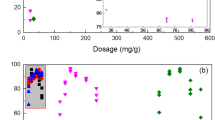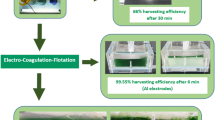Abstract
The purpose of this study was to explore efficient methods of harvesting the microalga Phaeodactylum tricornutum. Natural sedimentation experiments, performed at different light and temperature conditions, did not yield significant improvements in efficiency even after 1 week. When alkalinity-induced flocculation was performed, both the flocculation efficiency and the concentration factor dramatically improved at pH = 9.75 (0.5–0.7 units over the original pH of the culture) after 10 min settling time. Sedimentation rates are documented at pH ranging between pH 9.75 and 11.0. The results of the application of two conventional flocculants used in wastewater treatment, polyaluminium chloride and aluminium sulphate, are also presented. Chitosan was also used as a natural flocculating agent to improve possible contamination problems in the downstream process. pH was adjusted in order to determine optimum flocculation efficiency of chitosan in combination with a high concentration factor. Satisfactory results were found with chitosan at an adjusted pH of 9.9 using concentrations as low as 20 mg L−1, after testing a flocculant range of 5–200 mg L−1.








Similar content being viewed by others
References
Alexeyev V (1979) Quantitative analysis. Mir Publishers, Moscow
Alonso DL, Belarbi EH, Fernandez-Sevilla JM, Rodrıguez-Ruiz J, Grima EM (2000) Acyl lipid composition variation related to culture age and nitrogen concentration in continuous culture of the microalga Phaeodactylum tricornutum. Phytochemistry 54:461–471
Ayoub GM, Lee S, Koopman B (1986) Seawater-induced algal flocculation. Water Res 20:1265–1271
Blanchemain A, Grizeau D (1999) Increased production of eicosapentaenoic acid by Skeletonema costatum cells after decantation at low temperature. Biotechnol Technol 13:497–501
Bowler C, Allen AE, Badger JH et al (2008) The Phaeodactylum genome reveals the dynamic nature and multi-lineage evolutionary history of diatom genomes. Nature 456:239–244
Buelna G, Bhattarai KK, de la Noue J, Taiganides EP (1990) Evaluation of various flocculants for the recovery of algal biomass growth on pig-waste. Biol Wastes 31:211–222
Carvalho A, Meireles L, Malcata FX (2006) Microalgal reactors: a review of enclosed system designs and performances. Biotechnol Prog 22:1490–1506
Chen CY, Yeh KL, Alsyah R, Lee DJ, Chang JS (2011) Cultivation, photobioreactor design and harvesting of microalgae for biodiesel production: a critical review. Biores Technol 102:71–81
Csordas A, Wang JK (2004) An integrated photobioreactor and foam fractionation unit for the growth and harvest of Chaetoceros spp. in open systems. Aquacult Eng 30:15–30
Danquah MK, Gladman B, Moheimani N, Forde GM (2009) Microalgal growth characteristics and subsequent influence on dewatering efficiency. Chem Eng J 151:73–78
Divakaran R, Sivasankara Pillai VN (2002) Flocculation of algae using chitosan. J Appl Phycol 14:419–422
Dziubek AM, Kowal AL (1984) Effect of magnesium hydroxide on chemical treatment of secondary effluent under alkaline conditions. In: Proceedings of water reuse symposium III, American Waterworks Association Research Foundation, San Diego
Elmaleh S, Coma J, Grasmick A, Bourgade L (1991) Magnesium induced algal flocculation in a fluidized bed. Wat Sci Technol 23:1695–1702
Elmaleh S, Yahi H, Coma J (1996) Are flocculants required in a flocculant process? Env Eng Policy 1:97–102
Graves EC, Schnelle KB Jr, Wilson DJ (1979) Experimental verification of a mathematical model for quiescent settling of a flocculating slurry. Sep Sci Technol 14:923–933
Gualtieri P, Barsanti L, Passarelli V (1988) Chitosan as flocculant for concentrating Euglena gracilis cultures. Annal Instt Pasteur/Microbiol 139:717–726
Gudin C, Thepenier C (1986) Bioconversion of solar energy into organic chemicals by microalgae. Adv Biotechnol Proc 6:73–110
Guillard RRL, Ryther JH (1962) Studies of marine planktonic diatoms I. Cyclotella nana Hustedt and Detonula confervacea Cleve. Can J Microbiol 8:229–239
Harith ZT, Yusoff FM, Mohamed MS, Din MSM, Ariff AB (2009) Effect of different flocculants on the flocculation performance microalgae, Chaetoceros calcitrans, cells. Afr J Biotechnol 8:5971–5978
Horiuchi JI, Ohba I, Tada K, Kobayashi M, Kanno T, Kishimoto M (2003) Effective cell harvesting of the halotolerant microalgae Dunaliella tertiolecta with pH control. J Biosci Bioeng 95:412–415
Kaseamchochoung C, Lertsutthiwong P, Phalakornkule C (2006) Influence of chitosan characteristics and environmental conditions on flocculation of anaerobic sludge. Water Environ Res 78:2210–2216
Kerr RA (1998) The next oil crisis looms large and perhaps close. Science 281:1128–1131
Kim S-G, Choi A, Ahn C-Y, Park C-S, Park Y-H, Oh H-M (2005) Harvesting of Spirulina platensis by cellular flotation and growth stage determination. Lett Appl Microbiol 40:190–194
Knuckey RM, Brown MR, Robert R, Frampton DMF (2006) Production of microalgal concentrates by flocculation and their assessment as aquaculture feeds. Aquacult Eng 35:300–313
Lavoie A, de la Note J (1983) Harvesting microalgae with chitosan. J World Maricult Soc 14:685–694
Lee AK, Lewis DM, Ashman PJ (2009) Microbial flocculation, a potentially low-cost harvesting technique for marine microalgae for the production of biodiesel. J Appl Phycol 21:559–567
Leentvaar J, Rebhun M (1982) Effect of magnesium and calcium precipitation on coagulation flocculation with lime. Wat Res 16:655–662
McGarry MG (1970) Algal flocculation with aluminum sulfate and polyelectrolytes. J Wat Poll Cont Fed 42:191–201
Merrill DT, Jorden RM (1975) Lime-induced reactions in municipal waters. J Wat Pollut Cont Fed 47:2783–2808
Moheimani NR, Borowitzka MA (2006) The long-term culture of the coccolithophore Pleurochrysis carterae (Haptophyta) in outdoor raceway ponds. J Appl Phycol 18:703–712
National Algal Biofuels Technology Roadmap (2010). Available at www1.eere.energy.gov/
Packer M (2009) Algal capture of carbon dioxide; biomass generation as a tool for greenhouse gas mitigation with reference to New Zealand energy strategy and policy. Energy Policy 37:3428–3437
Papazi A, Makridis P, Divanach P (2010) Harvesting Chlorella minutissima using cell coagulants. J Appl Phycol 22:349–355
Rodolfi L et al (2009) Microalgae for oil: strain selection, induction of lipid synthesis and outdoor mass cultivation in a low-cost photobioreactor. Biotech Bioeng 102:100–112
Sander K, Murti GS (2010) The Life cycle analyses of algae biodiesel. Int J Life Cycle 15:704–714
Schenk PM, Thomas-Hall SR, Stephens E, Marx UC, Mussgnug JH, Posten C, Kruss O, Hankamer B (2008) Second generation biofuels: high-efficiency microalgae for biodiesel production. Bioenerg Res 1:20–43
Semerjian L, Ayoub GM (2003) High-pH–magnesium coagulation–flocculation in wastewater treatment. Adv Env Res 7:389–403
Spilling K, Seppälä J, Tamminen T (2010) Inducing autoflocculation in the diatom Phaeodactylum tricornutum through CO2 regulation. J Appl Phycol. doi:10.1007/s10811-010-9616-5
Spolaore O, Joannis-Cassan C, Duran E, Isambert A (2006) A commercial application of micro-algae. J Bioscie Bioeng 101:87–96
Strand SP, Varum KM, Kjetill O (2003) Interactions between chitosans and bacterial suspensions: adsorption and flocculation. Colloids Surf B Biointerfaces 27:71–81
Sukenik A, Shelef G (1984) Algal autoflocculation—verification and proposed mechanism. Biotechnol Bioeng 26:142–147
Vandamme D, Foubert I, Meesschaert B, Muylaert K (2010) Flocculation of microalgae using cationic starch. J Appl Phycol 22:525–530
Walne PR (1970) Studies on the food value of nineteen genera of algae to juvenile bivalves of the genera Ostrea, Crassostrea, Mercenaria, and Mytilis. Fishery Investigations. Series 2, London. pp 26–62
Wang LK, Hung Y-T, Shammas NK (2005) Physicochemical treatment processes. Handbook of environmental engineering, vol 3. Humana Press, New Jersey, p 113
Yahi H, Elmaleh S, Coma J (1994) Algal flocculation-sedimentation by pH increase in a continuous reactor. Wat Sci Technol 30:259–267
Zeng D, Wu J, Kennedy JF (2008) Application of a chitosan flocculant to water treatment. Carbohy Polym 71:135–139
Zhao YQ (2003) Correlations between floc physical properties and optimum polymer dosage in alum sludge conditioning and dewatering. Chem Eng J 92:227–235
Zhu CJ, Lee YK (1997) Determination of biomass dry weight of marine microalgae. J Appl Phycol 9:189–194
Acknowledgements
The authors are grateful to the Spanish Ministry of Science and Innovation for project ENE2007-65033 and to the Excma. Diputacio de Tarragona for the “Biomass Fuels” project under the microalgae research programme for the partial funding of this research. The authors also wish to thank Dr. Ester Clavero from IREC for her valuable work with the algal cultures.
Author information
Authors and Affiliations
Corresponding author
Rights and permissions
About this article
Cite this article
Şirin, S., Trobajo, R., Ibanez, C. et al. Harvesting the microalgae Phaeodactylum tricornutum with polyaluminum chloride, aluminium sulphate, chitosan and alkalinity-induced flocculation. J Appl Phycol 24, 1067–1080 (2012). https://doi.org/10.1007/s10811-011-9736-6
Received:
Revised:
Accepted:
Published:
Issue Date:
DOI: https://doi.org/10.1007/s10811-011-9736-6




